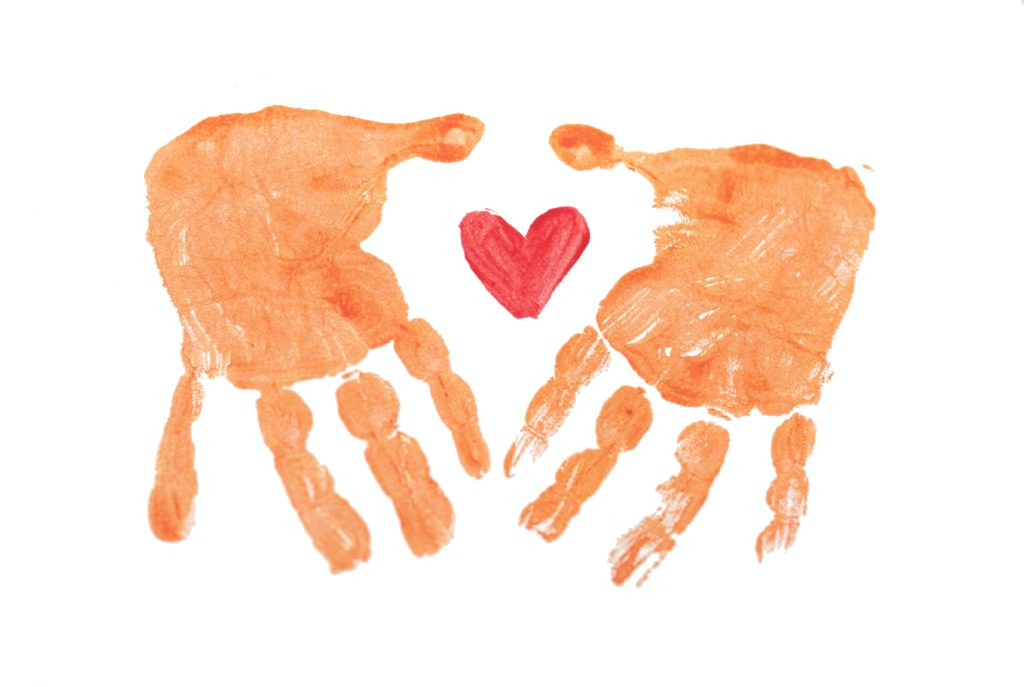
Introduction
In this article, we’re going to take a close look at how animal sanctuaries can create spaces that are accessible to and inclusive of blind and visually disabled folks who visit and work there. From the moment your sanctuary integrates accessibility and inclusion into your space, you create a sanctuary focused on the wellbeing of ALL its residents and community members. So, let’s dive in!
The Blind and Visually Disabled Communit(ies)

Although there is not a universally accepted definition of visual disability that is shared across all blind and visually disabled people, in general, it’s defined as a vision impairment that significantly impacts a person’s functional abilities and cannot be fully corrected to a “normal level” with regular eyeglasses, contact lenses, medication, or surgery. Visual disability does not generally encompass folks who can function well in everyday life with corrective lenses, though there are exceptions to this. Nonetheless, visual disability is a broad term that encompasses a wide variety of experiences whose impact on daily life differs from person to person.
Estimates vary as to the number of blind and visually disabled people there are in the United States, primarily due to a lack of a universally accepted definition of visual disability. However, the American Foundation for the Blind estimates there are around 500,000-700,000 children and 32 million adults who are visually disabled. Among these individuals, an estimated 2.5 million of them are blind. There are also an estimated 11,000 children and 40,000 adults who are DeafBlind and experience a combination of vision and hearing loss. The term “blind” generally means that the visual capacities of a person are insufficient to be used. However, blindness can take many forms and only about 15% of blind people experience a complete absence of vision. The other 85% are affected by things like light perception loss, peripheral vision loss, central vision loss, loss of visual acuity, depth perception issues, and colorblindness, or any combination thereof, and more. Deafblindness encompasses a spectrum as well, from mildly hard of hearing and mildly visually disabled to totally deaf and blind, or combinations thereof. Though there are no universally accepted definitions for many of the common terms and phrases used to describe blind and visually disabled people, you can learn more about the broad spectrum of vision disabilities folks can experience by checking out The National Federation of the Blind and The American Foundation for the Blind. Please be mindful, however, that blind and visually disabled people are all individuals with unique experiences and preferences. The terms and phrases used by The National Federation of the Blind, The American Foundation for the Blind, or any other organization or person are not necessarily the terms all blind and visually disabled people prefer to use. How someone wishes to identify themselves and be labeled is personal and dependent upon the individual, so always remember to check in with them and respect their preferences first!
Why Accessibility is Important
Accessibility is the Law
The Americans with Disabilities Act (ADAThe Americans With Disabilities Act, a law that governs accessibility requirements for organizations in the United States.) is a law that defines blindness and low vision as disabilities and thus, is intended to prevent discrimination against people who are blind or visually disabled. This means if you are operating an animal sanctuary within the United States that has been granted 501(c)3 status, has 15 or more employees, and/or is open to the public, you are required to comply with ADA accessibility standards and make your space and services as accessible as possible to people who are blind or visually disabled.
Language Around Accessibility is Important
Although there is not a monolithic language style preference shared across all disabled folks, it’s important to use as welcoming and respectful language as possible when communicating about accessibility. We would encourage the sanctuary community to adapt the cooler tonality of ADA language around accessibility to be a bit warmer for communicative and educational purposes.
Accessibility is the Right Thing to Do
Beyond the legal requirement, ensuring compliance with ADA standards also means that your organization is creating a more welcoming space for more people. If we understand disability as a mismatch between someone and their environment, we not only recognize that it’s the disabling environment that prevents the person from doing or accessing something, but that disability is also something that everyone experiences at some point throughout their life, whether it be permanent, temporary, or situational. In this way, accessibility can be thought of as an ongoing process of working towards finding solutions to disabling environments so that we can include more people in our spaces in more meaningful ways. Accessibility benefits everyone.
Accessibility for Blind and Visually Disabled People at Your Animal Sanctuary
When it comes to nurturing and creating a sanctuary space that is welcoming to blind and visually disabled people, it’s important to understand that each person has their own unique needs and preferences, so please always inquire with individuals first whenever possible. It’s also important to understand that an individual’s needs and preferences are often dependent upon setting. For example, onsite communication preferences and needs for blind and visually disabled people can look quite different than their offsite and online communication preferences and needs.
Although there are many different kinds of visual disabilities, individual needs, and preferences, there are also many ways that sanctuaries can facilitate access to their spaces in ways that benefit everyone. In the sections that follow, this resource provides a broad non-exhaustive overview of various kinds of accommodations and technologies sanctuaries can explore to achieve this.
Offsite Accessibility for Blind and Visually Disabled People
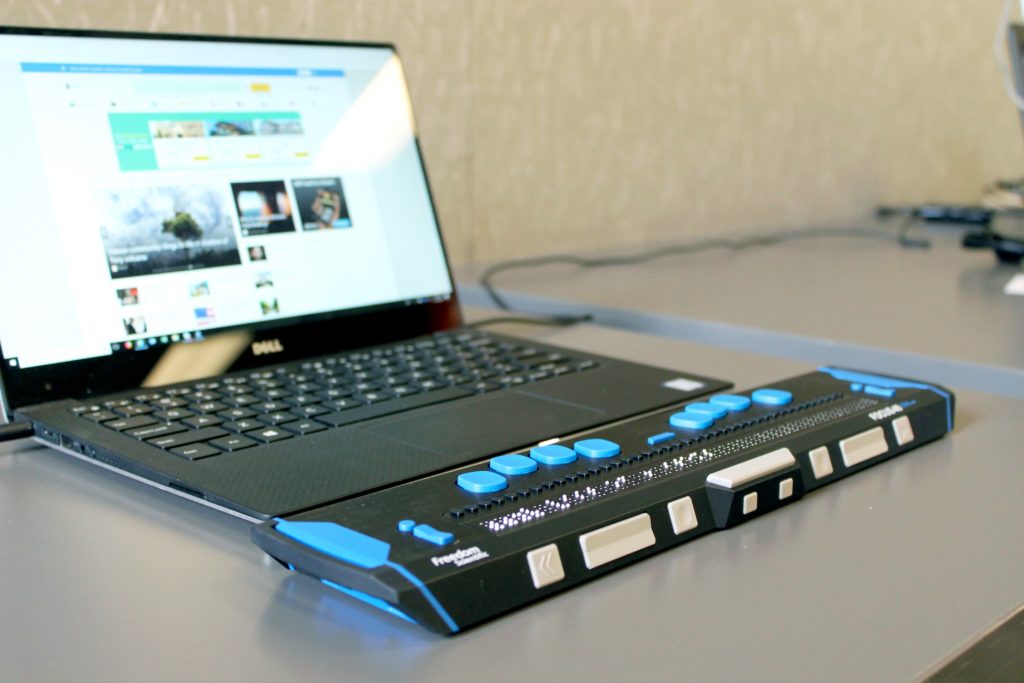
Website and Social Media Accessibility
In compliance with ADA standards for blind and visually disabled individuals, it’s important that your sanctuary has a website that is suitable for screen-readers, has alternative text descriptions for all visual elements and images, utilizes clear text descriptions for all navigation elements such as links, and makes every activity on its website easily accessible through the use of a keyboard and not just a mouse (e.g., Tab and Shift+Tab to navigate forward and backward). Your sanctuary’s website should also utilize a clean and simple font type like Sans Serif, Arial, or Verdana and a font size of at least 14pt. Please be mindful that capitalized text is sometimes read incorrectly by screen readers. There should also be a significant contrast between the colors of your website’s text and the background the text is on (e.g., black text on a white background). Finally, it’s important that you include any important pre-visit information (e.g., your sanctuary’s location/town, information on public transit if applicable, optimized routes, location of accessible pedestrian signals if applicable, information on street works, nearby accessible venues, etc.), multiple contact methods (e.g., phone, email, live chat, text, etc.), and a statement such as “Please be in touch if you need any accommodations and we will do our best to accommodate”. This is by no means an all-inclusive list, but it should give you an idea of some of the most important elements to include on your website. Incorporating these simple elements allows blind and visually disabled people to communicate with you more easily and become familiar with your sanctuary’s mission, space, and accommodations more readily. To learn about other ADA requirements and continually evolving compliance standards regarding website elements, please check out this guide from the Web Accessibility Initiative and this guide from Digital Authority Partners. Your sanctuary might also consider scheduling a website ADA compliance evaluation on a regular basis with an expert website agency to help fix any potential issues you may have on your site.
What to Include in Alternative Text and Image Descriptions
Alternative text (Alt Text) is the description you write for each image on your website and social media channels so disabled users, particularly blind and visually impaired folks, can access your images audibly with a screen reader or visually in the caption or comments of a photo. Alt text should include descriptions of the most important aspects of an image such as any humans or nonhumans including their skin/hair/fur/feather/scale color, eye color, clothing, poses, facial expressions, as well as the details of any objects, buildings, backgrounds, surroundings, and text.
Example Alt Text for the Photo Below: A photograph of an alpaca looking at the camera while chewing a mouthful of grass. He has long dark brown fiber all over his body and a patch of white fiber below his black nose that looks like a mustache. His eyes are dark brown and his bottom teeth are sticking out as he chews. This is a close-up photo of the alpaca’s face. There is a bright green pasture behind him.

Online Educational Programming Accommodations
It’s important to build accessibility into any education program you create and there are a lot of accommodations to consider when you facilitate one online. For blind and visually disabled people specifically, providing audiotaped, brailled, or electronically formatted workshop notes, handouts, and texts can be really beneficial. It can also be beneficial to record meetings and presentations, establish participation protocols with the whole group, build in pauses, and utilize alt text and verbal descriptions of visual aids throughout your programming. When you are addressing a blind or visually disabled person on an online platform, you should always use their first name when addressing them. Example: “Hi Patricia, it’s Ana. How are you doing today?” You should also always verbalize what you are doing or referencing and avoid vague words like “here, there, over there”. Additionally, if you are using any kind of application software like Powerpoint, Google Slides, or Word Processor, we recommend presenting in full screen mode as much as possible and using enlarged clean and simple fonts (e.g., Sans Serif, Arial, Verdana, APHont, Dyslexic Font) and high contrast colors (e.g., black text on a white background). It’s also important to keep your presentation layouts simple. As a guiding principle, it’s helpful to keep text and images to a minimum – no more than 5 lines of text and no more than 2 images on any slide. All images should have ample space between them so that visually disabled folks who have some residual vision can see them separately.
This is not an exhaustive list of accommodations and it’s very important that you maintain a continuing dialogue with your blind and visually disabled participants before, during, and after your program so that you can honor their individual communication needs and preferences.
Onsite Accessibility for Blind and Visually Disabled People
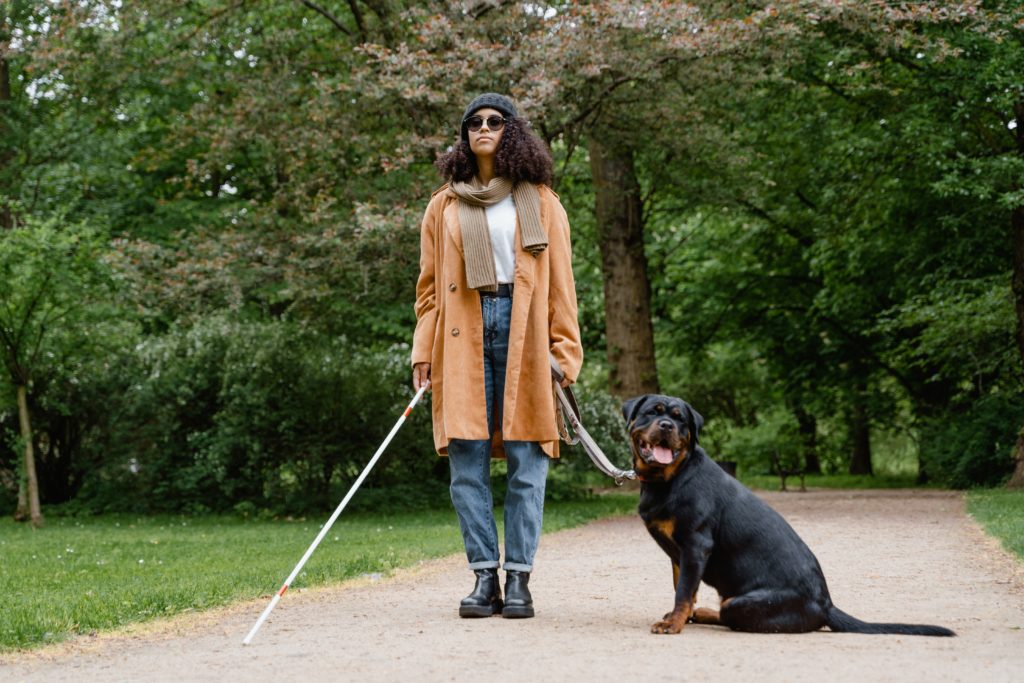
There are a lot of technologies, services, and accommodations that sanctuaries can incorporate and build into their onsite spaces, educational programs, and budgets that would make them more welcoming for blind and visually disabled community members. Establishing accessibility requirements early in your educational programming and sanctuary design can also help ensure that each staff member knows their responsibility and can be held accountable for upholding an inclusive environment. This will ensure that you’re not only following ADA legal requirements, but making sure all blind and visually disabled visitors, staff members, and volunteers have the best possible experience at your sanctuary!
Face-to-Face Interaction and Communication with Blind and Visually Disabled Community Members
Although every blind and visually disabled person is an individual whose unique needs and preferences should be respected first and foremost whenever possible, we recommend reviewing the following generally accepted guidelines regarding face-to-face interaction and communication when you welcome these community members to your animal sanctuary.
When a blind or visually disabled person enters your sanctuary, it’s important to introduce yourself and welcome them to the space. You should always approach folks calmly, position yourself directly in front of them, then say who you are and what position you hold at the sanctuary. If you already know the person’s name, use it. Example: “Hi there! My name is Ana. I’m one of the humane educators here at Humming Hollow Animal Sanctuary and I wanted to welcome you to our space today. Please let me know if you need any specific accommodations and we will do our best to provide them.” If your sanctuary already provides any particular accommodations for blind and visually disabled people, describe them now so they know what they can ask from you. If they are unable to hear you, you can get their attention by slightly touching their arm. This also lets them know you are speaking to them, and not someone else nearby. Do not shout at folks. Please always be mindful that your body position and distance from an individual, ambient noise, lights, pace of conversation, and number of speakers or people in the space can all have an impact on the communication needs of blind and visually disabled people. So, plan your interaction accordingly and do your best to accommodate your conversation in an appropriate setting. If you are unavailable to have an extended conversation right away, say so. Example: “Hi there! My name is Ana. I’m one of the humane educators at Humming Hollow Animal Sanctuary and I’d like to welcome you to our space today. I’m taking care of two other people right now, but will be with you to chat right after I finish”.
If you see a blind or visually disabled person that appears in need of assistance at any point in time at your sanctuary, introduce yourself (again) and ask the person if they need assistance. If assistance is requested, provide it. If it is not requested, do not provide it or insist upon trying to help if the person does not want it. If a blind or visually disabled person asks you for directions, be specific and use words and phrases such as “The restroom is straight ahead”, “turn left”, “on your right”, “the visitor center is 10 feet to your left”, etc. Do not use vague directional words and phrases like “that way” or “over there”. If you are asked to guide a blind or visually disabled person at your sanctuary, ask the person if they would like to take your elbow. If they accept, allow them to touch or hold your arm and follow as you walk. In general, you should walk about a half a pace ahead of the person you are guiding, but make adjustments as needed. If you approach any sort of narrow space, move your guiding arm behind your back so the person you are guiding can step behind you and follow single-file. If you approach a bump on the ground, curb, or flight of stairs, pause briefly and tell the person you are guiding whether the curb or stairs go up or down and if there is a handrail. Then allow the person to find the handrail and locate the edge of the curb or first stair before proceeding. Always say when the top or bottom of stairs has been reached. If you approach a door, let the person know which way the door opens and which side the hinges are on. You should go through the door first and allow them to follow while holding your elbow or arm. If the blind or visually disabled person asks for assistance in sitting on a chair, use the arm they are holding to grip the back of the chair and allow them to feel where it is and sit down by themselves.
Do not ever grab a blind or visually disabled person by the hand, arm, shoulder, or cane and attempt to steer them. Please also be careful not to distract, petAn animal who spends regular time with humans in their home and life for companionship or human pleasure. Typically a small subset of animal species are considered to be pets by the general public., feed, or grab the harness of a guide dog. Many blind and visually disabled folks depend on these animal companions to move around safely. For more information on how to safely guide a blind or visually disabled person, we recommend checking out these detailed sighted guide techniques from the Wisconsin Department of Health Services.
Environmental Accommodations
Environmental accommodations may include physical adjustments to your sanctuary space(s) that improve mobility, audibility, visibility, and safety for everyone, but particularly for blind and visually disabled folks. In addition to all of the physical adjustments and accommodations your sanctuary can consider implementing, it is of the utmost importance to make sure all staff members and volunteers are informed when a blind or visually disabled visitor, volunteer, or staff member is onsite so that everyone can work together to create as safe and welcoming an environment as possible.
Signage
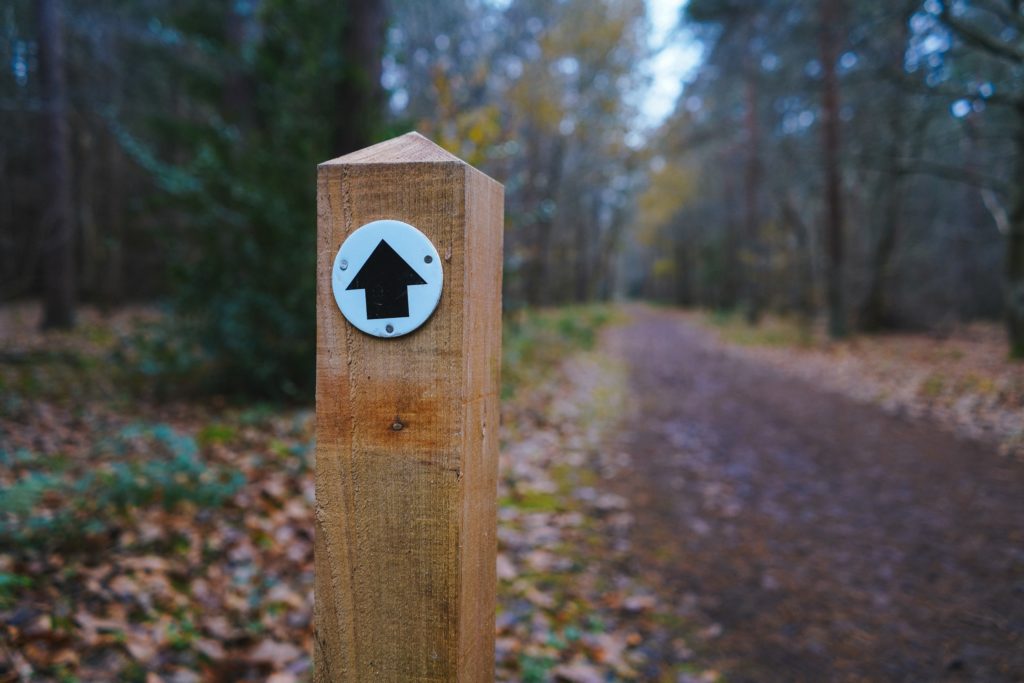
Make sure any necessary information such as safety signs, directions, opening hours, points of interest within your sanctuary (e.g., parking, reception, visitor center, restrooms, exits), room numbers or names, etc. can easily be read and identified with proper signage. Remember, many people who are legally blind or deal with other vision disabilities have some degree of residual sight, so a clear signage system can be incredibly beneficial. With clear signage that uses large print, contrasting colors, pictograms, and braille, blind and visually disabled folks can find their way around your sanctuary more safely, independently, and at their own pace.
Accommodate Folks Who Experience Colorblindness
When creating signage for your sanctuary, try to avoid using red and green or blue and yellow together. People with colorblindness will not be able to differentiate those combinations of colors. It can also be helpful to use patterns in addition to colors to create greater contrast between different parts of a sign.
Parking
Folks who are blind or visually disabled should have access to parking spaces that are closest to wherever they need to go (e.g., visitor center, office, restroom facility). Please be mindful and build extra room into these parking spaces to allow folks who also use wheelchairs to put their vehicle ramps down and get off safely without having to go into the flow of any kind of traffic.
Lighting
Visually disabled folks who have some residual vision are generally more sensitive to quality lighting, so you might want to consider changing or adding lighting to certain spaces at your sanctuary to enhance visibility. Bright natural-looking light that minimizes glare is ideal, particularly around barriers on walkways, under stairs, and under cabinets.
Paths

An accessible sanctuary enables blind and visually impaired people to get around as easily as possible, so consider creating pathways at your sanctuary that utilize:
- Braille trails! Your animal sanctuary might consider building pathways on its property with braille informational signs and physical aids that can allow blind and visually disabled folks to walk around and experience educational tours more comfortably. Braille trails usually have guide rope for folks to hold and follow along the path with markers like short poles or wooden posts with plaques for braille informational signs.
- Tactile walkways or ground surface indicators to indicate where it’s safe to walk as well as changes between areas designated for different groups of people such as, visitors, tour guides, caregivers, vehicles, etc. You will need to notify blind and visually disabled folks as soon as they arrive on your sanctuary’s property if you decide to use any particular kind of tactile paving to accommodate them. Do not use textures on your paths or floors that could be mistaken for the standard wayfinding cues that people with visual disabilities look for unless you are going to use them correctly. It is of the utmost importance that there are no divots, cracks, or seams large enough to allow someone to trip or a cane to get stuck. If appropriate tactile paving is not an option at your sanctuary, ensure that pathway surfaces for disabled folks are completely flat and firm. You can still add safe ground surface indicators at certain points to indicate where it’s safe to walk if you’d like, but just make sure blind and visually disabled folks are aware of these and what they mean ahead of time!
- Elongated ridges or grass edging to help people who are blind and visually disabled detect where they can safely walk .
- Straight lines and clear corners. Curvy paths can be confusing for blind and visually disabled folks.
- Railings. Blind and visually disabled individuals can run their hands along a railing and use it as a guide to avoid stepping off a path.
- Obstacle-free routes. Keep trees, plants, trashcans, cars, equipment, and any other objects out of pathways as much as possible when they are in use. If you have trees along a pathway, make sure they do not hang down low enough to hit someone in the head. You might also consider using mulch or contrasting fencing around trees to let folks know they are there.
- Changes in flooring texture (pavement, mulch, tile, wood, textured rugs) to indicate doorways or openings to other areas. Just be sure the change in floor texture isn’t too high or low enough to create a tripping hazard for anyone.
Barriers
Barriers like fences can be incredibly helpful for blind and visually impaired folks to determine the boundaries of a particular space. If additional fencing is not possible or appropriate in certain areas at your sanctuary, consider installing short poles or posts that are about waist high and marked by very high contrasting colors so people can see or reach for them to distinguish a particular area’s edges.
Stairs
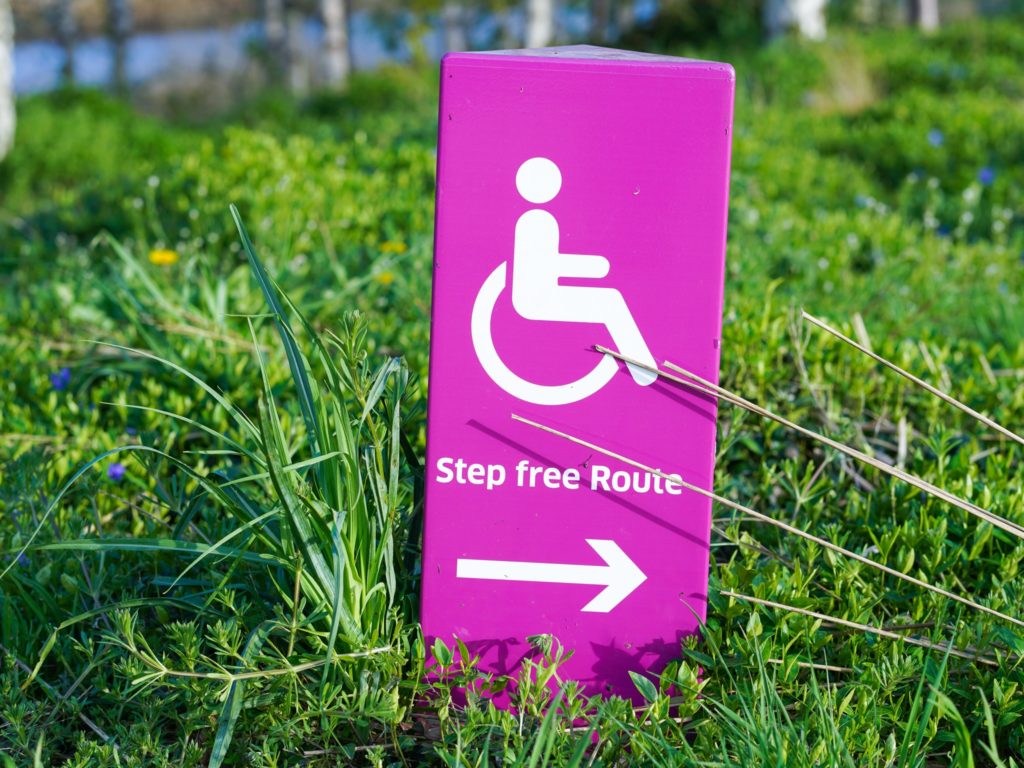
If there are stairs located anywhere on your sanctuary’s property, you might consider installing and utilizing things like:
- Detectable warning surfaces (e.g., raised stripes, textured tape, contrasting colors) and visual aids to alert someone that they have reached the beginning or end of a set of stairs or the edge of a step
- Continuous handrails that are placed at a natural level on both sides of a stairway
- Contrasting risers and stair nosings
- Alternatives to stairs like ramps, which are generally more helpful for everyone!
Doorways and Windows
- Clear glass on doors and windows can be challenging for visually disabled folks to see, so consider utilizing things like decals, stickers, dots, stripes, etching, or glazing to improve visibility.
- Add high contrast colors to flooring near doorways and around the frame of a door to help folks discern when they’re approaching one.
- Expand doorways (at least four feet wide) whenever possible to avoid potential bottlenecks and allow folks comfortable passage. This is particularly helpful for people with reduced peripheral vision and for folks who utilize wheelchairs.
Restrooms
- Make sure restroom signage is in large print and, if possible, tactiled/brailled.
- Ensure doorways to bathrooms are large enough for folks who use wheelchairs to comfortably get inside, turn around, and then leave.
- Use contrasting colors inside restrooms to help folks clearly discern where the toilet, toilet paper, sink, paper towels, walls, etc., are located.
- Install secure grab bars for folks to utilize in key locations to increase safe mobility while in the restroom.
Design Accessible Spaces Correctly
There are a lot of wonderful resources out there that go into great detail on how to design and build truly accessible spaces. A simple Google search can aid you in the process and we encourage you to have a close look so you can do it correctly!
Audible Emergency Notifications
Install emergency auditory alarms that work in conjunction with flashing lights so you can accommodate visually disabled and Deaf and hard of hearing folks.
Mobility Aids
There are a lot of mobility aids available to help blind and visually disabled people move around more safely. Folks with visual disabilities may prefer to use these aids independently or with some assistance. Needs and preferences look different for everyone and they can change from day to day and place to place!
Human Assistance
People who are blind or visually disabled sometimes require the assistance of other humans. If they are visiting your sanctuary, they may bring a friend, guide, or other mobility aid with them that allows them to get around on their own sufficiently or they may request help from one of your staff members. So, it’s always a good idea to have your staff trained in welcoming people with visual disabilities. Giving folks the choice to decide what they need and what’s best for them matters!
Guide Dogs
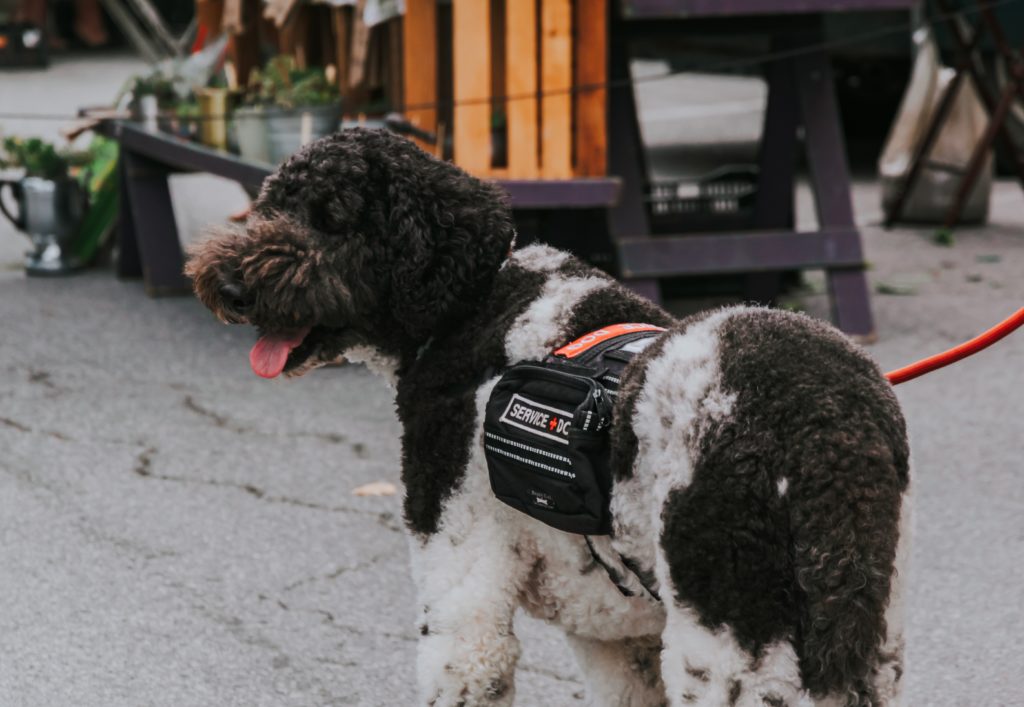
Guide dogs can be important mobility aids for many folks, though it’s estimated that only around 2% of blind and visually disabled people work with them. Oftentimes, these dogs will wear a vest or a harness that identifies them as a guide dog. The harness is also an indicator that lets the dog know they are currently aiding a disabled person. Guide dogs are typically trained to help disabled people deal with specific situations such as crossing roads and bypassing obstacles and physical boundaries like curbs and barriers, but they are also sometimes trained to perform tasks like medical response, deep pressure therapy, retrieval, and more. Please note, guide dogs are not able to read signs or react to color or texture contrasts.
Guide dogs are classified as medical equipment under the ADA, which grants them access under federal law to any public accommodation except for places like hospital operating rooms, restaurant kitchens, and religious facilities. If you are operating an animal sanctuary within the United States that is open to the public, you are only allowed to ask visitors with guide dogs two questions regarding entry into your space during public visitation hours: Is this dog a service animal that helps with your disability? What tasks do they perform? Under the ADA, the dog can only be excluded or removed from a public accommodation if they are not under control of their owner. They cannot be denied entry based on things like fear or allergies. As such, it’s very important to think about how your sanctuary can accommodate visitors with guide dogs safely while also considering the comfort, needs, and safety of all your residents.
Wheelchairs
There are multiple types of wheelchairs, though the two most common types are manual and powerchairs. The need or preference for a wheelchair can change depending on the person as well as the situation and setting. Some blind and visually disabled folks require them all the time or part-time.
White Canes
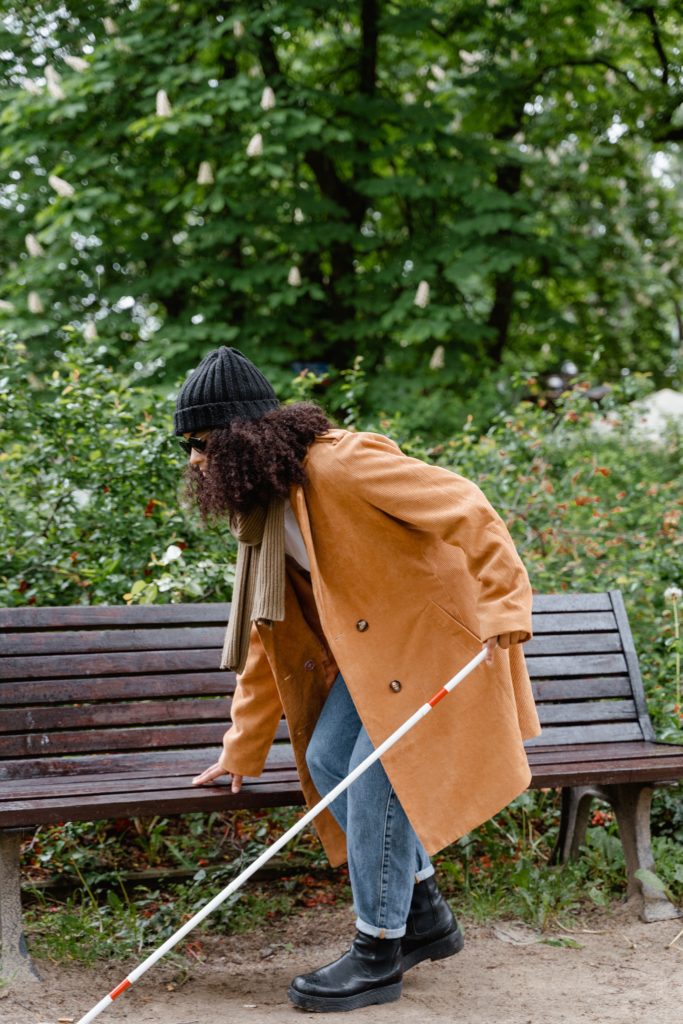
There are many different kinds of white canes that help blind and visually impaired people move around more safely. Some are used to help folks navigate around obstacles and locate their surroundings (e.g., guide canes, long canes) while others are used for physical support and to let people know that someone has a vision disability (e.g., white walking sticks, symbol canes). A red section on a white cane oftentimes means that the person using it is visually disabled and hard of hearing or deaf.
Tour Considerations
For many blind and visually disabled folks, taking tours of public spaces and venues that do not take their needs into consideration makes them feel excluded. However, there are many ways that animal sanctuaries can facilitate educational tours that are more inclusive of and enjoyable for blind and visually disabled people. So, let’s explore some of them!
Assistive Technologies
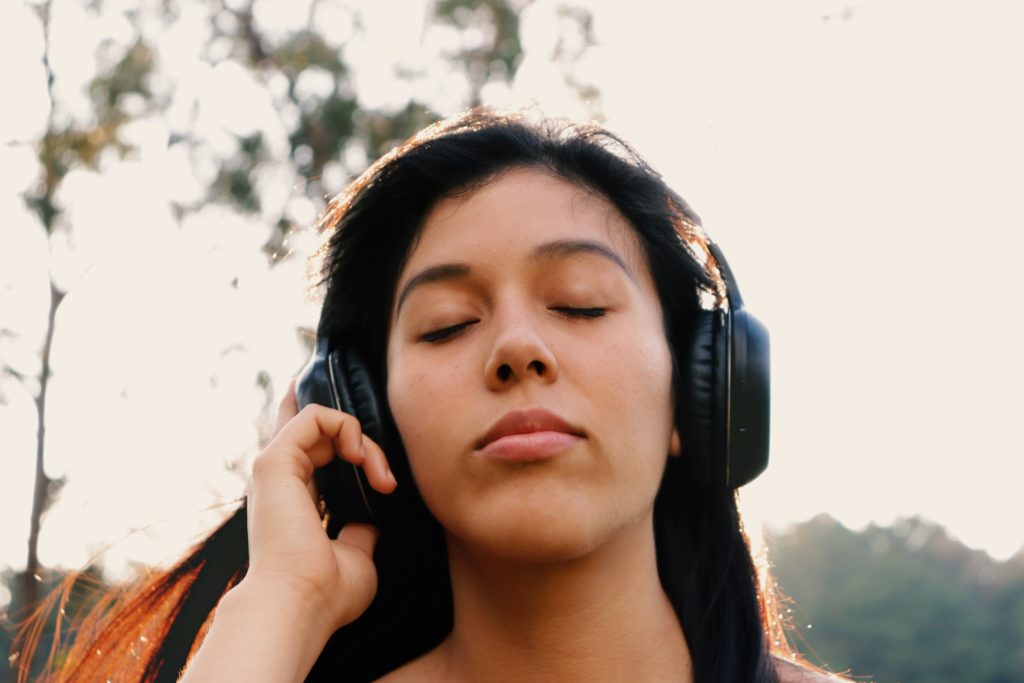
In addition to the physical adjustments your sanctuary can make to improve mobility, audibility, visibility, and safety for blind and visually disabled folks, there are also a lot of helpful assistive technologies and services to consider incorporating into your space, particularly for educational tours.
- Tactile Aids (e.g., Braille): Although not a lot of blind and visually disabled people utilize braille, those who do will really appreciate it if you offer braille descriptions of points of interest and residents at your sanctuary through signage, brochures, or other educational materials. Many DeafBlind people, for example, require braille and other tactile materials for communicative and educational purposes.
- Audio Aids: If your sanctuary is providing information textually or visually, then it should also be providing that same information audibly in some way. This could be through live tours with humane educators who are speaking directly to participants or through audiotaped scripts and guides that allow folks to go on tours more independently. If you are providing live in-person tours, we recommend utilizing microphones or other assistive listening systems that can amplify sound.
- Smart Phones, Tablets, and Computers: Blind and visually disabled people are often reliant on assistive technologies such as screen readers, braille displays, navigation apps, and speech recognition software that can be installed on smartphones, tablets, and computers. Many folks will travel with and bring their own assistive devices and technologies, but it’s helpful for sanctuaries to know about some of them and offer them when they can.
- Screen readers convert what’s on a computer screen into information that can be displayed through synthetic speech or braille output (with a braille display).
- Braille displays are assistive devices that turn text on a screen into braille and connect to a computer or cell phone via USB or Bluetooth. Each braille display contains one or more rows of cells that can each be formed into the shape of a braille character.
- “Voice Dream Reader” is an input app that allows you to put your smartphone or iPad over some text and it will read it out loud to the person using it. It can also be used to read aloud text that can be pulled from PDFs, web browsers, Word docs, PowerPoint, HTML, and Dropbox.
- Voice assistants on smartphones can provide basic navigation, but they do not always work well with screen readers.
- “BlindSquare” is the world’s most widely used navigation app developed for blind, visually disabled, and DeafBlind people that provides detailed information about places of interest and is designed to work with screen readers.
- “Evelity” is a navigation app that can help disabled visitors find their way around larger spaces more independently. In addition to providing step-by-step audio instructions to guide blind and visually disabled visitors and adapting to users’ specific needs, the app can also provide supplemental information about pre-specified areas at places like a larger animal sanctuary. Your sanctuary might consider utilizing this tool to offer some version of a self-guided tour for blind and visually disabled folks!
- “Be My Eyes” is a free app that allows blind people to find support through video calls. Sighted users can sign up as a volunteer and offer assistance for visual tasks like reading print when they are available.
Sighted Guide Tours

For blind and visually disabled people, having educational tours designed specifically to help them connect with your sanctuary’s residents and mission can be incredibly meaningful. For this reason, we recommend building sighted guide tours into your budget and programming whenever possible. Training someone to facilitate these kinds of tours isn’t as challenging as you might think. Take a look at some of our ideas and tips below and consider how you could train/hire a tour guide to conduct tours and other educational programs for blind and visually disabled people at your sanctuary on a regular basis. Once you’ve built this kind of accessibility into your programming, make sure you include a statement on your website such as “Tours for blind and visually disabled folks are available upon request”.
Trained sighted guides should…
- Work with each group or individual prior to the start of the tour to determine what they need and what you can offer them.
- Give very rich descriptions of the sanctuary and its surroundings, including details such as color, texture, shape and landmarks.
- Give very rich descriptions of the sanctuary’s residents. Example: “This alpaca has long brown hair, a really long tail, and tufts on her ears. Her teeth also stick out kinda funny.”
- Provide specific distances. Example: “About 100 feet away, the donkeys are rolling in the sand. They like to do that because it helps keep the flies away. You also hear the pigs in the distance about 200 feet away. They are excited because it’s their dinner time!”
- Be very careful to let blind and visually disabled folks know when there is an obstacle, such as a dip, bump, rock, or gate, along their path.
- Be very careful to let blind and visually disabled folks know when they are too close to a resident, object, piece of equipment, or building that could potentially harmThe infliction of mental, emotional, and/or physical pain, suffering, or loss. Harm can occur intentionally or unintentionally and directly or indirectly. Someone can intentionally cause direct harm (e.g., punitively cutting a sheep's skin while shearing them) or unintentionally cause direct harm (e.g., your hand slips while shearing a sheep, causing an accidental wound on their skin). Likewise, someone can intentionally cause indirect harm (e.g., selling socks made from a sanctuary resident's wool and encouraging folks who purchase them to buy more products made from the wool of farmed sheep) or unintentionally cause indirect harm (e.g., selling socks made from a sanctuary resident's wool, which inadvertently perpetuates the idea that it is ok to commodify sheep for their wool). them. You do not want someone to get knocked over by a cowWhile "cow" can be defined to refer exclusively to female cattle, at The Open Sanctuary Project we refer to domesticated cattle of all ages and sexes as "cows." who’s reaching their gigantic head over the fence to greet a visitor or get head butted through the fence by an ambitious goat with horns!
- Invite participants to experience the sanctuary and its residents through other senses like smell, touch, and sound. Think about tactile things your sanctuary could allow visitors to explore with their hands like sheared wool/fiber, a trimmed pig tusk, molten feathers, hay, straw, barn siding, and more! You could create a sensory bin filled with grain and have a volunteer or staff member build a 3D model of your shelter structure(s) that visually disabled folks can touch to gain a better understanding of how the residents live.
- Walk slowly and allow participants to take in the experience, stop, ask questions, and clarify points. Some folks with residual vision might even like to utilize their own personal magnifying equipment to look more closely at something along the way.
Resident Considerations

Sometimes, animal sanctuaries offer opportunities for certain residents to meet and interact with visitors inside their living spaceThe indoor or outdoor area where an animal resident lives, eats, and rests.. When appropriate and safe for visitors and residents, the same opportunity can be offered to blind and visually disabled folks as well. However, for safety purposes, it might be worth creating and designating a space outside of a resident living area where a trained staff member can bring one of the residents to blind or visually disabled folks and allow them to meet and interact. Please take extra care determining if and with whom this might be appropriate. For starters, you should not allow overly enthusiastic residents to run up to visitors right away and put their head in their lap. This can be overwhelming for anyone, but particularly for blind and visually disabled people. Instead, you might consider choosing a resident who has an especially gentle disposition, can be haltered and walk up to people slowly, and/or doesn’t mind being touched. For example, if you have a chicken who really likes interacting with visitors and being held, a trained staff member might hold the chicken in their arms or lap and then invite the blind or visually disabled person to gently touch them and feel their warmth. Direct experiences like this can be particularly meaningful for visually impaired folks since hearing about a cow who is hundreds of feet away in a pasture is quite different from getting to gently stroke a cow’s forehead or having their hand licked by a cow’s giant tongue as they slurp up a tasty treat.
Sanctuary Residents and Consent
Allowing folks to observe and/or interact with animal companions either inside or outside of their living space should only be done after carefully considering the issue of consent and the interests, needs, and safety of each individual. For some residents, it’s very clear that they enjoy interacting with humans and/or being taken out of their living space, and for others, it’s very clear that they do not. There are also residents whose interest in interacting with humans and/or being taken out of their living space is unclear. Unlike petting zoos, which sell guaranteed interactions with animals, it is critical that animal sanctuaries respect the autonomyThe ability for individuals to have access to free movement, appropriate food, and the ability to reasonably avoid situations they wish to avoid. and space of its residents to the greatest extent possible. Their interest in and ability to interact with guests largely depends on their personality, mood, and current mental, emotional, and physical state. Some individuals are comfortable interacting with humans, but uncomfortable being taken away from their living area. If one of your residents usually enjoys being taken away from their living area and interacting with humans, please take all the necessary steps to ensure they continue to feel this way and that the setting away from their living space is comfortable and safe for them prior to bringing them there. If it is currently unclear what they want, we advise against taking them away from their living space and/or allowing them to interact with human visitors.
A Word of Caution
Extra careful consideration needs to be made for residents that are at any increased risk of stress, illness or injury, including already sick or injured animals, babies, and elderly companions. We would advise against bringing any of these particularly vulnerable individuals outside of their living areas and allowing them to interact with human visitors to ensure their safety and the safety of humans. As a general guiding principle, if you feel the slightest bit concerned for an animal’s physical or mental well-being and safety, then you should not allow them to be handled or taken away from their living area with the exception of healthcare purposes.
Check Back In!
The Open Sanctuary Project is in the process of developing a resource that will take a much deeper dive into the issue of consent and respectful human-animal interaction, so please check back in! In the meantime, if you have thoughts about this issue that you’d like to share with us, feel free to get in touch with us here.
Workplace Inclusion for Blind and Visually Disabled Sanctuary Employees
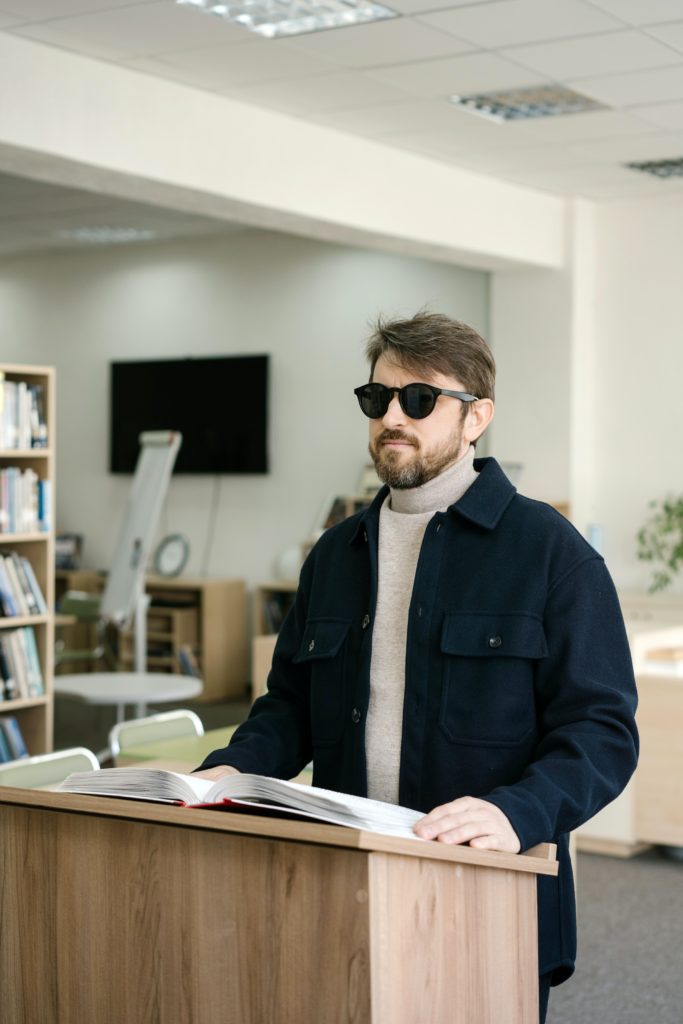
Currently in the United States, approximately only 45% of blind and visually disabled people are employed. This is partly due to a lack of welcoming and inclusive workspaces where blind and visually disabled folks feel comfortable. As an employer, it is your responsibility to provide reasonable workplace accommodations for blind and visually disabled employees. This means providing them with equal employment opportunities to participate in the application and interview processes, communicate effectively in the work space, have access to the resources they need to succeed in their position, have access to facilities or portions of facilities to which all employees are given access (e.g., lunch rooms), attain the same level of performance as other employees in the same position, participate in trainings, meetings, professional development opportunities, and social events, and enjoy all the other benefits of employment at your sanctuary. Please remember that accessibility looks different for everyone and communication preferences and needs vary depending on the setting and the individual so it’s important to maintain an ongoing dialogue with employees who are blind or visually disabled. Primary consideration should always be given to the individual’s preference. By law, you are not required to provide blind and visually disabled employees with “personal use items” (e.g., corrective eyeglasses) or accommodations that would result in the removal of an essential job duty, violation of job-related conduct rules, or an undue hardship to your organization (e.g., cost). If you determine that the cost of a specific accommodation would cause your organization an undue hardship, please try reaching out to your state vocational agencies and disability organizations to see whether they can help offset some of the expenses. There are also federal tax credits and deductions available in many states.
In addition to the technologies, services, and accommodations we listed in the previous sections of this resource for onsite and offsite visitors, most of which should also be extended to sanctuary employees, the information below is a list of more technologies, services, and accommodations you can build into your sanctuary workspace(s) that are specifically for blind and visually disabled staff members.
Interview Considerations
Prior to the Interview
- Ask the applicant how they would prefer to communicate during the interview. Are there any specific assistive technologies or environmental accommodations they’d like you to provide? For example, if a DeafBlind individual requests a tactile sign language interpreter, coordinate to have one.
- Send the applicant a written and an audiotaped copy of the interview itinerary, questions, and any pertinent information on your organization
During the Interview
- Maintain an open dialogue with the candidate throughout the process regarding communication needs and preferences. Remain flexible in the event that they ask you to communicate or do something differently.
- If you have printed materials to give to the candidate during the interview, offer to read them out loud or provide extra lighting if it’s helpful. If these are take-home materials, you should also provide them with an audiotaped version.
Communication Considerations
All staff members should be educated on how to provide a welcoming and inclusive environment to blind and visually disabled colleagues, perhaps through a special training session or workshop. Prior to working together, all staff members should also be notified of and honor a blind or visually disabled employee’s preferred communication methods. With that said, communications between staff members should always be available in accessible formats such as large print, audio, or braille. If, for whatever reason, your organization cannot provide information in these ways at some point, ensure that there is a designated staff member that is responsible for transcribing any written communications into a format that your blind and visually disabled employees would prefer.
Assistive Technologies
There are a lot of assistive technologies that can improve accessibility and/or visibility for blind and visually impaired employees. In addition to the aforementioned ones, these might also include digital recorders, magnification devices, scanning devices, screen-reading software, closed circuit television systems (CCTV), refreshable braille displays, and braille embossers.
Environmental Considerations
- Maintain an open dialogue with blind and visually disabled staff members regarding appropriate workspace arrangements and honor their preferences and needs to the best of your ability. In general, all pathways should be obstacle-free and all documents and resources should be as physically accessible as possible.
- If requested, provide blind and visually disabled employees with a special keyboard, telephone, chair, or desk that they require.
- If requested, provide blind and visually disabled folks a modified work schedule, permission to work from home, and/or additional time off.
- If requested, provide blind and visually disabled employees with a driver or payment for the cost of transportation to enable any essential job tasks that require traveling.
- If necessary, make modifications to allow guide dogs a safe space in your workplace.
Considerations for Orientations, Trainings, Meetings, Professional Development Opportunities, and Social Events
- Send staff members an audiotaped, braille, and/or large print copy of the group’s itinerary and any other pertinent information in advance of getting together.
- If requested, coordinate to have a tactile sign language interpreter available.
- Change or add lighting to enhance visibility of the space, speakers, and interpreters.
- Use round or oval tables.
- Establish participation protocols with the entire group:
- Establish an audible signal that staff members should use when they want to contribute.
- Audibly indicate who will be speaking.
- Allow only one person to communicate at a time. They should look at the audience when they communicate, not have their back turned.
- Ask blind and visually impaired staff members how they prefer others get their attention.
- Ensure a designated staff member is transcribing all meeting minutes and notes into an audible, braille, large print, or other accessible format.
- Utilize audio and tactile aids.
Additional Emergency Accommodations
- Walk through emergency evacuation routes during employee orientations and trainings.
- Establish a buddy system by designating a sighted person with a blind or visually disabled person during emergency situations.
- Communicate with staff members audibly during an emergency.
- Although blind and visually disabled folks are particularly sensitive to their environments, concerns about not seeing potentially dangerous animals or farm equipment that are prevalent on many sanctuary properties are important to take into consideration. It might be beneficial to create a liability waiver for staff members and volunteers if you haven’t already done so to acknowledge there is going to be risk associated with sanctuary work and that each party is trying to do everything they can to mitigate that risk.
Program Evaluation
Program evaluation research is one of the most meaningful ways to determine how you can improve your sanctuary’s space and educational programming and as such, should seek to include feedback from blind and visually disabled community members. Developing a strong understanding of blind and visually disabled folks who visit and work in your space is one of the most effective ways of ensuring that you are providing a welcoming and inclusive environment. This research might look like a survey given at the end of an educational program or to an employee that says something such as, “We’re doing our best with what we know and we’d love to know one that thing that we can do better. What’s one thing that we can do to make your next visit even better and more welcoming?”. The most important aspect of this research is what you do with the results. So make sure you are following through with your intentions to make your sanctuary as welcoming as possible based on what folks are reasonably asking for. Performative statements are not helpful.
Additional Resources for Your Sanctuary to Explore
Below is a list of additional resources we recommend for more in-depth guidance on creating and nurturing spaces that are welcoming and inclusive of blind and visually disabled people.
- The National Federation of the Blind
- The American Foundation for the Blind
- American Council of the Blind
- ADA National Network: You can find your local ADA Center on this website.
- National Center on DeafBlindness
- DeafBlind Interpreting has a page with information and recommendations on where to find tactile sign interpreters
- Guide Dogs for the Blind
- National Council of State Agencies for the Blind (NCSAB) maintains a directory of state-by-state agencies serving blind and visually impaired individuals. If you do not see an agency listed for your state, we recommend reaching out to your state’s vocational rehabilitation agency for additional support and referrals.
- Local community centers for blind and visually disabled people
- Council of Schools and Services for the Blind
- Education programs within local schools for blind and visually disabled people
- State commissions for blind and visually disabled people
Article Acknowledgements
This resource could not have been created without the shared knowledge of Brenda Vetter from SoL Criations Farm Sanctuary. We are incredibly grateful for her contributions.
Sources
Accessibility for Deaf and Hard of Hearing Community Members at Your Animal Sanctuary | The Open Sanctuary Project
ADA Compliance and Accessibility for Animal Sanctuaries | The Open Sanctuary Project
In-Person Sanctuary Educational Programming: What Are Your Options? | The Open Sanctuary Project
Virtual Sanctuary Educational Programming: What Are Your Options? | The Open Sanctuary Project
Effective Website Elements for Your Animal Sanctuary | The Open Sanctuary Project
All About Social Media for Your Animal Sanctuary | The Open Sanctuary Project
Fundamentals of an Effective Animal Sanctuary Tour Program | The Open Sanctuary Project
Understanding Mission and Vision Statements for Your Animal Organization | The Open Sanctuary Project
A Starter Guide to Common Questions Your Sanctuary Gets Asked and How to Thoughtfully Answer Them | The Open Sanctuary Project
The Differences Between an Animal Sanctuary and a Petting Zoo | The Open Sanctuary Project
Accident Waiver and Release of Liability Template for Animal Sanctuaries | The Open Sanctuary Project
Education Program Evaluation for Animal Sanctuaries | The Open Sanctuary Project
Animal Sanctuary Visitor Surveys: How to Capture the Data that Counts | The Open Sanctuary Project
Blindness and Vision Impairments in the Workplace and the ADA | U.S. Equal Employment Opportunity Commission
Posts | Disability Together [Instagram Profile]
Statistical Snapshots from the American Foundation for the Blind | The American Foundation for the Blind
Fast Facts of Common Eye Disorders | Centers for Disease Control and Prevention
National Federation of the Blind
The American Foundation for the Blind
WCAG 2 Overview | Web Accessibility Initiative
The Ultimate Guide to Achieving ADA Website Compliance | Digital Authority Partners
Do’s and Don’ts When Interacting With a Person Who is Blind | Wisconsin Department of Health Services
What You Need to Know About Wayfinding Tiles | Access Tile
What is a Braille Trail? | Nature for All
Mobility Aids | Fighting Blindness
Guide Dog Access Laws | Guide Dogs for the Blind
Assistive Technology Products | American Foundation for the Blind
Americans with Disabilities Act Guide for Places of Lodging: Serving Guests Who Are Blind or Who Have Low Vision | U.S. Department of Justice
How to Create a Smart City for Blind and Visually Impaired People | Inclusive City Maker
The Ultimate Guide to Designing and Navigating Spaces for People with Vision Impairment | Big Rentz








